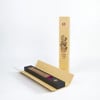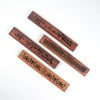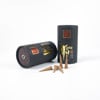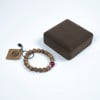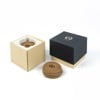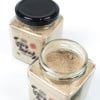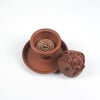Belief in Avalokitesvara in the hearts of Vietnamese people
Religious beliefs are a common cultural factor, present very early in the history of human civilization.
Buddha statue with thousand eyes and thousand hands at But Thap pagoda, Bac Ninh (Source: Internet)
In the lives of Vietnamese people, the image of Quan The Am has been deeply ingrained in the hearts of many people, expressed in many aspects of life, in literary works and in the field of art.
In literature and art, Vietnamese people have built for themselves the image of Quan The Am with bold cultural nuances of the Vietnamese people, putting into it their aspirations and beliefs about a peaceful and happy life.
Before discussing the belief of Bodhisattva Avalokitesvara in Vietnam, let me briefly summarize the integration of Buddhism into Vietnam. Buddhism, a major religion of the East, has spread from the Ganges valley to many different parts of the world: From Ceylon, Burma, Thailand to Central Asian countries, China, Japan, Vietnam Nam... Buddhist teachings have many similarities with the traditional life ethics of the Vietnamese people, so it quickly assimilated into Vietnamese culture after being transmitted. During the development process in Vietnam, Buddhism had a transformation and became Vietnamese Buddhism with the characteristics of the Vietnamese people, which are different from Buddhism in other countries.
Speaking of Vietnamese culture, we cannot help but mention folklore and art. Because literature and folk art are two important parts to the national culture. They are formed on the basis of indigenous culture and selectively absorb other cultures. They are like mirrors that honestly reflect the spiritual and material life of people and ancient society.
Bodhisattva beliefs appeared in our country quite early. And the ancient Vietnamese skillfully put the Bodhisattva beliefs in general and the Avalokitesvara Bodhisattva beliefs in particular into poems, literary works, festivals, and art sculptures. …
In Vietnamese poetry, the image of Bodhisattva Avalokitesvara is mentioned as a kind mother, with a tolerant heart, giving joy and relief to children who are in distress:
"The old father is Buddha Shakyamuni
An old mother is like Guan Yin Buddha."
The image of Bodhisattva Avalokitesvara mentioned in the above verse shows that his father from thousands of years ago worshiped him with a very respectful heart but also very close and dear. Bodhisattvas and Buddhas are likened to a common father and mother that we need to repay for our grace; need to respect, study and follow the noble virtues. The image of Bodhisattva Avalokitesvara has been instilled in the minds of many Vietnamese; that reflects our people's thoughts and beliefs in Him.
Not only in poetry, his image is also imprinted in valuable literary works. Besides Buddhist scriptures and fairy tales, there are two literary works related to Bodhisattva Avalokitesvara that are widely propagated in folklore, namely Quan Am Nam Hai and Quan Am Thi Kinh. The two works contain the Buddha's compassionate philosophy, along with thrilling and fascinating details; contains the filial piety, compassion, patience, and altruism of Bodhisattva Avalokitesvara. Thereby we realize the positive side in the thinking of his father in the past was hating the bad and loving and honoring the beautiful.
We can come across a familiar pattern in the works. That is the image of Bodhisattva Avalokitesvara appearing as a savior, carrying in her all the quintessence, the best, the most benevolent to represent the good and punish the evil. This image speaks of the longing of the Vietnamese people in the past, which is the desire for a fair life and also shows their belief in cause and effect: "In kindness, you will meet good, in evil, you will meet evil". Through that, they want to pass on to their descendants the messages of love and human duty.
Besides literary works and folk songs, the image of Avalokitesvara is also a cultural beauty in traditional holidays and days of worship of the Vietnamese people. Through research trips to folklore during festivals, scholars have encountered images of Avalokitesvara in festivals. Although there are variations in form to suit the culture of the region, all of them share the common feature of expressing their belief in compassion, saving suffering, and connecting love between people and people. People.
In addition to the days when Bodhisattva Avalokitesvara is held in the temple such as February 19, June 19, and September 19 (A.L.) that Buddhists often know, there are many festivals in folklore. related to the Bodhisattva Avalokitesvara, which is modified depending on the needs, desires and purposes of each festival. Typically, the Huong Pagoda Festival, a traditional festival of our Vietnamese people. The image of Avalokitesvara appearing in the festival is the image of the Buddha with miraculous powers that folk still say that the Perfume Pagoda is a sacred place, in the past, there was Buddha Ba Quan Am incarnate to save suffering. Or the festivals of the sea fishermen. Looking at this, we can see that Vietnamese people always believe in Bodhisattva Quan Am, believing that he can protect them in times of danger.
The influence of Bodhisattva Avalokitesvara in the culture of the Vietnamese people is also recognized in architectural works of art. In Vietnam, the image of Bodhisattva Avalokitesvara is posed in the form of a woman. According to Buddhist philosophy, Buddha and Bodhisattva are neither male nor female. But when introduced to Vietnam, as well as some other countries, Bodhisattva Avalokitesvara turned into a woman and was likened to a gentle mother. And no matter how the outer appearance of Bodhisattva Avalokitesvara is sculpted, they all exude a majesty and loving beauty.
It can be seen that the image of Bodhisattva Avalokitesvara has long become too familiar in Vietnamese cultural life. Everywhere in Vietnam, stretching from the North to the South, everywhere we see a statue of this Bodhisattva. He is present in pictures, in classic literature and in words; and even in festivals, in sculpture. She is the symbol of a gentle mother with boundless love and boundless tolerance. The Vietnamese people, who used to live in a war-torn situation, have seen firsthand the suffering caused by war and often witnessed natural disasters and droughts. Therefore, they dream of having a peaceful life, settling down in a peaceful career and believing in the protection of the gods. Therefore, the image of Bodhisattva Avalokitesvara represents great compassion, great compassion, patience, and infinite sympathy, which easily takes root and spreads widely among the masses.
Source: Bao Giac Ngo

























